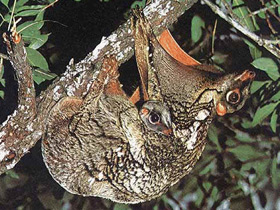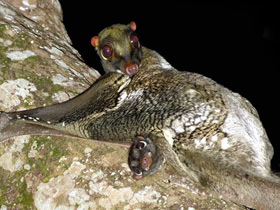Colugos (order Dermoptera)
Colugos (/kəˈluːɡoʊ/) are arboreal gliding mammals that are native to Southeast Asia. Their closest evolutionary relatives are primates. There are just two living species of colugos: the Sunda flying lemur (Galeopterus variegatus) and the Philippine flying lemur (Cynocephalus volans). These two species make up the entire family Cynocephalidae (/ˌsaɪnoʊˌsɛfəˈlaɪdi, kɛ/) and order Dermoptera (not to be confused with Dermaptera, an order of insects known as earwigs).
Dermoptera, also called colugos, are an order of placental mammals with only two extant species belonging to the only family of the order, Cynocephalidae. This order is closely related to the ancient insectivores. Dermoptera have some distinctive features of semimonkeys, bats and insectivores, but cannot be assigned to any of these orders. The vagueness of their position in taxonomy has placed many naturalists in great difficulty. Linnaeus classifies them as semimonkeys, Cuvier as bats, Jofroy as predators, Oken as marsupials, and finally Peter as insectivores, whose order ends with this family.
According to Lech's research, Dermoptera form a separate order. In their organisation they are placed below all the related groups named. Because of the vagueness of this subdivision, the animals have many names: winged monkeys, flying poppies, flying cats, amazing bats, etc.
Family Cynocephalidae
The most striking feature of the Cynocephalidae is their dense hair-covered membrane that extends between the forelimbs and hind limbs, starting at the neck, behind the ears on the sides of the body and ending at the tip of the tail. Cynocephalidae are able to glide by means of this web, but cannot fly (although they have a small keel on the sternum, like birds).
The Cynocephalidae is a true arboreal animal that, thanks to its webbing, can make long gliding leaps, as if flying from one tree to another. Once at the top of the crown, the Cynocephalidae launches itself into the air, performing a silent, gliding flight. It spreads the folds of its skin, spreading its legs wide and extending its tail. In flight, this animal can adjust its direction by changing the position of its webbing.
It glides elegantly between trees, covering a distance of up to 140 m, with a slight loss of height. When approaching a target tree, the Cynocephalidae lifts its hindquarters, brings its body into an upright position and touches the trunk with four legs at the same time. After climbing up the trunk in short, sharp jumps, it gains height and takes another flight.
On the ground, Cynocephalidae crawl with great difficulty and try to climb any vertical object.
Appearance and peculiarities
All members of the Cynocephalidae have five toes, are long and slender, and are equipped with strong, sharp claws that allow them to cling to trees and hang on to branches like sloths.
They have 34 teeth; the upper canines and upper outer incisors have two roots each, which is a rare exception among animals. The lower incisors have numerous longitudinal grooves on the inside, which makes the tooth look like a comb. A similar structure is seen in lemurs, but in lemurs the comb is formed by individual teeth, whereas in Cynocephalidae each tooth is divided by twenty grooves. This peculiarity is apparently used to scrape the pulp from leaves when feeding and also to comb wool.
This strange creature is between 36 and 43 cm long and weighs 2 kg, the tail of the Cynocephalidae varies from 11 to 27 cm. The head of the Cynocephalidae is small and broad, with short, almost hairless, rounded ears and large eyes, perfectly adapted for binocular vision, which help them to see in the dark. On the bare soles of their feet are flat pads that form suction discs, allowing Cynocephalidae to land safely on trees (or other surfaces). The hair covering the entire body and webs of Cynocephalidae is very soft and dense. The colour of the animals is usually greyish-brown on top, with indistinct yellowish-white spots on the sides and light brown or yellowish-brown on the underside.
Distribution
Cynocephalidae are distributed in the tropical forests of Southeast Asia and its neighbouring islands and are found in forests, coconut plantations and other crops. Cynocephalidae have a strictly arboreal and nocturnal lifestyle. They never deliberately descend to the ground, as the drooping folds of their skin prevent them from moving quickly and agilely on vertical surfaces, leaving them virtually defenceless.
Cynocephalidae are quite adept climbers. Hugging the trunk of a tree with their long legs and sharp claws, they climb in short bursts. They move along the branches and feed by hanging down, clinging to the branches with their strong legs. As nocturnal animals, Cynocephalidae spend the day in holes or hollows in trees 25-50 m above the ground, but in coconut plantations they curl into a ball or hang from a palm branch, clinging tightly with all four legs.
At dusk, the Cynocephalidae climb to the top of the tree and from there begin to glide in search of food, covering a distance of about 1-1.5 km in one night. Only 1-2 species of Cynocephalidae are known in modern fauna.
Cynocephalidae are very clean and carefully groom their fur with their teeth.
Social behaviour and reproduction
Several individuals may live in the same area, but these animals always move alone at night. Friendly interactions have been observed between adults of opposite sexes and between adults and juveniles, but adult males sometimes show hostility towards each other.
They feed exclusively on plant foods: leaves, flower buds and tree fruits. Like many arboreal mammals, Cynocephalidae obtain sufficient water from food or by licking wet leaves.
Cynocephalidae stick to certain areas of the forest, apparently strictly assigned to each individual. Cynocephalidae breed once a year. They breed throughout the year, regardless of the season. Pregnancy lasts 60 days. The female usually gives birth to one young, rarely two. Newborns are extremely helpless, naked and blind. The mother leaves the young in the nest, or carries it with her, twisting its tail so that it looks like a pouch.
It spends about 6 months clinging to its mother's belly, which moves and jumps into trees with it. They are not separated from their mother for a long time, and sometimes large, half-grown young are seen still clinging to their mother and hanging on to her belly. Cynocephalidae reach maturity at the age of 3 years. The oldest Cynocephalidae in captivity remained in captivity for 17.5 years before escaping.
Cynocephalidae and humans
In some areas Cynocephalidae are hunted by local people for their delicious meat and soft fur, either by lasso or bow hunting. However, the main threat to the existence of Cynocephalidae is agricultural development, which is accompanied by the clearing of primary forests. In areas where protected patches of rainforest remain, Cynocephalidae can coexist with humans. In Malaysia, the Cynocephalidae often inhabit coconut plantations and feed on the flowers of these trees.
Taxonomy
Their family name Cynocephalidae comes from the Greek words κύων kyōn "dog" and κεφαλή kephalē "head" because their heads are broad with short snouts like dogs.
Classification and evolution
Order Dermoptera
- †Family Plagiomenidae:
- †Planetetherium;
- †Planetetherium mirabile;
- †Plagiomene;
- †Plagiomene multicuspis;
- †Family Mixodectidae:
- †Dracontolestes;
- †Dracontolestes aphantus;
- †Eudaemonema;
- †Eudaemonema cuspidata;
- †Mixodectes;
- †Mixodectes pungens;
- †Mixodectes malaris;
- Family Cynocephalidae:
- Cynocephalus;
- Philippine flying lemur, Cynocephalus volans;
- Galeopterus;
- Sunda flying lemur, Galeopterus variegatus;
- †Dermotherium;
- †Dermotherium major;
- †Dermotherium chimaera.
The Mixodectidae and Plagiomenidae appear to be fossil Dermoptera. Although other Paleogene mammals have been interpreted as related to dermopterans, the evidence for this association is uncertain and many of the fossils are no longer interpreted as being gliding mammals. At present, the fossil record of definitive dermopterans is limited to two species of the Eocene and Oligocene cynocephalid genus Dermotherium.
Recent molecular phylogenetic studies have demonstrated that colugos emerged as a basal Primatomorpha clade which is a basal Euarchontoglires clade. Treeshrews (order Scandentia) emerged as sister of Glires (lagomorphs and rodents), in an unnamed sister clade of the Primatomorpha.

















































